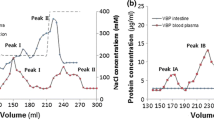Abstract
Sea cucumbers are a potential source of natural organic vanadium that may improve insulin resistance. In this work, vanadium was accumulated rapidly in blood, body wall, and intestine by sea cucumber Apostichopus japonicus. Furthermore, water-soluble vanadium-containing proteins, the main form of the organic vanadium, were tentatively accumulated and isolated by a bioaccumulation experiment. It was also designed to evaluate the beneficial effect of vanadium-containing proteins (VCPs) from sea cucumber rich in vanadium on the development of hyperglycemia and insulin resistance in C57BL/6J mice fed with a high-fat high-sucrose diet (HFSD). HFSD mice treated with VCPs significantly decreased fasting blood glucose, serum insulin, and HOMA-IR values as compared to HFSD mice, respectively. Serum adiponectin, resistin, TNF-α, and leptin levels in insulin-resistant mice were dramatically reduced by a VCP supplement. These results show an ameliorative effect on insulin resistance by treatment with VCPs. Such compound seems to be a valuable therapy to achieve and/or maintain glycemic control and therapeutic agents in the treatment arsenal for insulin resistance and type 2 diabetes.



Similar content being viewed by others
References
Jennings JR, Rainbow PS (1979) Studies on the uptake of cadmium by the crab Carcinus maenas in the laboratory. I. Accumulation from seawater and a food source. Mar Biol 50:131–139
Jinadasa BKKK, Samanthi RI, Wicramsinghe I (2014) Trace metal accumulation in tissue of sea cucumber species; north-western Sea of Sri Lanka. Am J Public Health 2:1–5
Pfaender S, Grabrucker AM (2014) Characterization of biometal profiles in neurological disorders. Metallomics 6:960–977
Liu Y, Zhou Q, Xu J, Xue Y, Liu X, Wang J, Xue C (2015) Assessment of total and organic vanadium levels and their bioaccumulation in edible sea cucumbers: tissues distribution, inter-species-specific, locational differences and seasonal variations. Environ Geochem Health. doi:10.1007/s10653-015-9689-9
Liu X, Xue C, Wang Y, Li Z, Xue Y, Xu J (2012) The classification of sea cucumber (Apostichopus japonicus) according to region of origin using multi-element analysis and pattern recognition techniques. Food Control 23:522–527
World health organization (1988) Environmental health criteria 81: vanadium. In: International T (ed) Programme on chemical safety (IPCS). WHO, Geneva
Ramasubbu R (2002) Insulin resistance: a metabolic link between depressive disorder and atherosclerotic vascular diseases. Med Hypotheses 59:37–551
Pillai SI, Subramanian SP, Kandaswamy M (2013) A novel insulin mimetic vanadium-flavonol complex: synthesis, characterization and in vivo evaluation in STZ-induced rats. Eur J Med Chem 63:17
Clark T, Deniset J, Heyliger C, Pierce G (2014) Alternative therapies for diabetes and its cardiac complications: role of vanadium. Heart Fail Rev 19:123–132
McNeill JH, Yuen VG, Hoveyda HR, Orvig C (1992) Bis(maltolato)oxovanadium(IV) is a potent insulin mimic. J Med Chem 35:1489–1491
Cocco MT, Onnis V, Ponticelli G, Meier B, Rehder D, Garribba E, Micera G (2007) Synthesis, characterisation and insulin-mimetic activity of oxovanadium(IV) complexes with amidrazone derivatives. J Inorg Biochem 101:19–29
Han C, Yuan J, Wang Y, Li L (2006) Hypoglycemic activity of fermented mushroom of Coprinus comatus rich in vanadium. J Trace Elem Med Biol 20:191–196
Trivedi S, Ueki T, Yamaguchi N, Michibata H (2003) Novel vanadium-binding proteins (vanabins) identified in cDNA libraries and the genome of the ascidian Ciona intestinalis. Biochim Biophys Acta 1630:64–70
Ueki T, Adachi T, Kawano S, Aoshima M, Yamaguchi N, Kanamori K, Michibata H (2003) Vanadium-binding proteins (vanabins) from a vanadium-rich ascidian Ascidia sydneiensis samea. Biochim Biophys Acta 1626:43–50
Yamaguchi N, Amakawa Y, Yamada H, Ueki T, Michibata H (2006) Localization of vanabins, vanadium-binding proteins, in the blood cells of the vanadium-rich ascidian, Ascidia sydneiensis samea. Zool Sci 23:909–915
Liu Y, Xu H, Xu J, Guo Y, Xue Y, Wang J, Xue C (2015) Vanadium-binding protein from vanadium-enriched sea cucumber Apostichopus japonicus inhibits adipocyte differentiation through activating WNT/β-catenin pathway. J Funct Foods 17:504–513
Baran EJ, Ferrer EG, Williams PAM (1995) Interaction of the vanadyl(IV) cation with ascorbic acid and related systems. J Inorg Biochem 59(2–3):600
Liu Y, Xu J, Xue Y, Wang J, Chang Y, Xue C (2015) Determination of trace vanadium in sea cucumbers by ultrasound-assisted cloud point extraction and graphite furnace atomic absorption spectrometry. Int J Environ Anal Chem 95:258–270
Fang Y, Catron B, Zhang Y, Zhao L, Caruso JA, Hu Q (2010) Distribution and in vitro availability of selenium in selenium-containing storage protein from selenium-enriched rice utilizing optimized extraction. J Agric Food Chem 58:9731–9738
Warnau M, Dutrieux S, Ledent G, Baena AMRY, Dúbois P (2006) Heavy metals in the Sea cucumber holothuria tubulosa (echinodermata) from the Mediterranean posidonia oceanica ecosystem: body compartment, seasonal, geographical and bathymetric variations. Environ Bioindic 1:268–285
Michibata H, Uchiyama J, Seki Y, Numakunai T, Uyama T (1992) Accumulation of vanadium during embryogenesis in the vanadium-rich ascidian, Ascidia gemmata. Biol Trace Elem Res 34:219–223
Yoshihara M, Ueki T, Watanabe T, Yamaguchi N, Kamino K, Michibata H (2005) VanabinP, a novel vanadium-binding protein in the blood plasma of an ascidian, Ascidia sydneiensis samea. Biochim Biophys Acta 1730:206–214
Ueki T, Shintaku K, Yonekawa Y, Takatsu N, Yamada H, Hamada T, Hirota H, Michibata H (2007) Identification of vanabin-interacting protein 1 (VIP1) from blood cells of the vanadium-rich ascidian Ascidia sydneiensis same. Biochim Biophys Acta 1770:951–957
Yang J, Kang J, Guan Y (2013) The mechanisms linking adiposopathy to type 2 diabetes. Front Med 7:433–444
Acknowledgments
This research was supported by the Program for Changjiang Scholars and Innovative Research Team in University (IRT1188). We gratefully acknowledge the College of Food Science and Engineering, Ocean University of China, for financial support. We greatly appreciate suggestions from anonymous referees for the improvement of this article.
Author information
Authors and Affiliations
Corresponding author
Rights and permissions
About this article
Cite this article
Liu, Y., Zhou, Q., Zhao, Y. et al. Enrichment, Distribution of Vanadium-Containing Protein in Vanadium-Enriched Sea Cucumber Apostichopus japonicus and the Ameliorative Effect on Insulin Resistance. Biol Trace Elem Res 171, 167–175 (2016). https://doi.org/10.1007/s12011-015-0517-y
Received:
Accepted:
Published:
Issue Date:
DOI: https://doi.org/10.1007/s12011-015-0517-y



